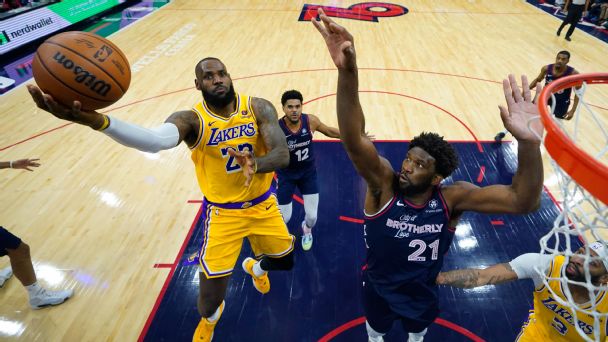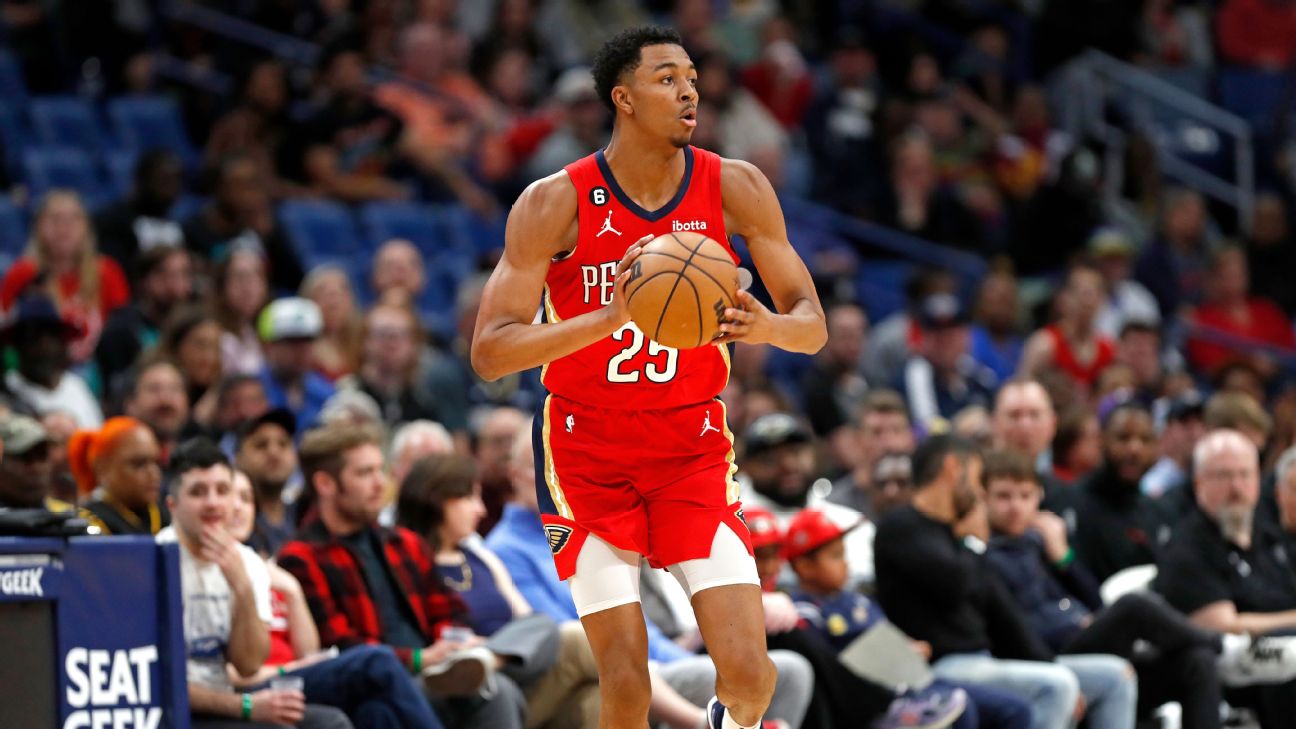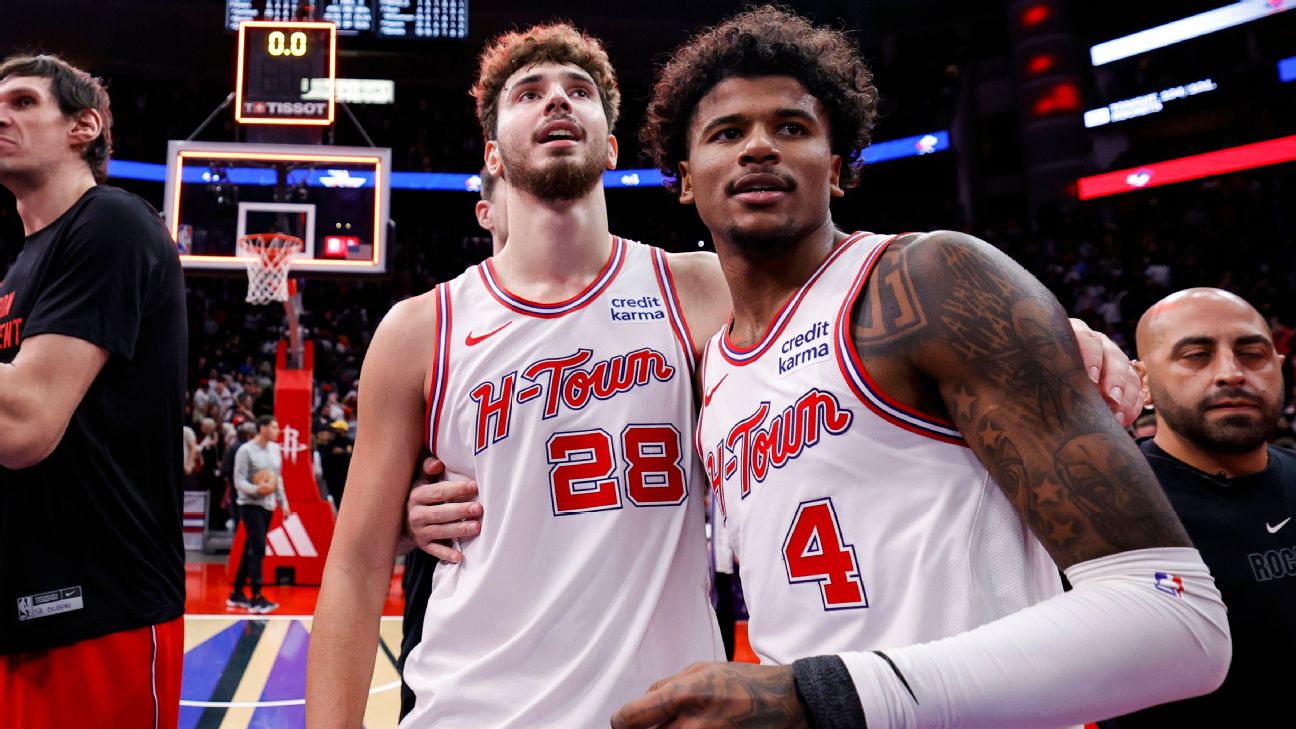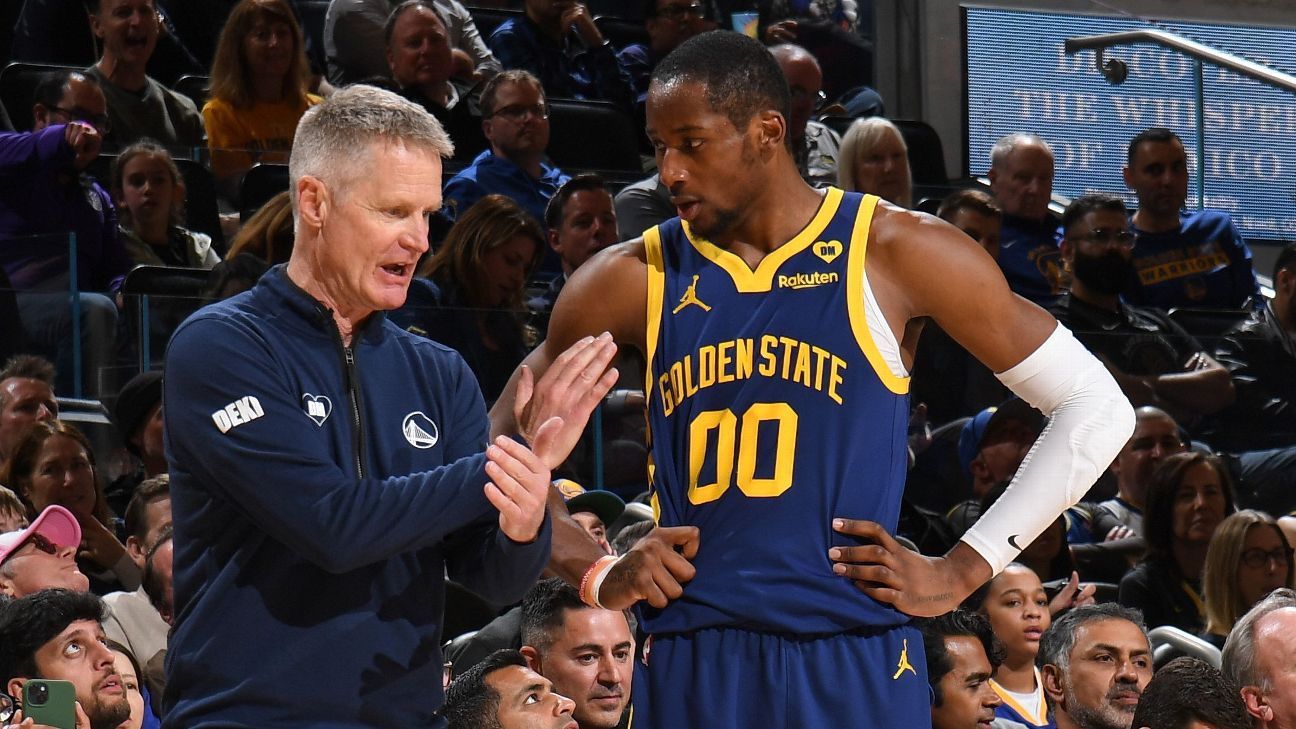With the NBA’s inaugural in-season tournament in the books and the Los Angeles Lakers having raised the NBA Cup, it’s time to look ahead to the next marquee event on the league’s schedule: February’s All-Star Game.
My choices for players performing at an All-Star level over the first quarter of the regular season include a rookie — which hasn’t happened since Los Angeles Clippers forward Blake Griffin in 2011 — and four other first-timers, two as starters in the Eastern Conference. Three other starters squared off in Saturday’s in-season tournament final between the Lakers and Indiana Pacers.
Using advanced player metrics as a guide, I selected the 12 players in each conference who have performed the best so far according to the NBA’s typical format — two backcourt starters and three in the frontcourt, the same number of reserves and two wild-card selections regardless of position.
Since some players will see their fast starts cool after the season’s first 20 games and other established stars will return to form, this isn’t exactly the way I’d select All-Star teams. Nonetheless, it offers a useful look at which players have been the best so far during the 2023-24 season. Let’s take a look at my teams.
Eastern Conference starters
![]() Backcourt: Tyrese Haliburton, Indiana Pacers
Backcourt: Tyrese Haliburton, Indiana Pacers
It’s a testament to how well Haliburton has played this season that his 20-point, 11-assist performance in Saturday’s final qualified as relatively disappointing. Steve Nash’s career is the best comp for what Haliburton has done. His true shooting percentage (TS%), which factors in shooting on 2s, 3s and free throws to capture scoring efficiency, is 17% better than league average — a little less than Nash’s best (21% in 2006-07, the season after his back-to-back MVPs). But Haliburton is carrying a heavier load with a 26.5% usage rate (Nash peaked at 24%) and is averaging just 2.3 turnovers per 36 minutes. Nash averaged 3.7 turnovers per 36 playing for coach Mike D’Antoni in Phoenix.
![]() Backcourt: Tyrese Maxey, Philadelphia 76ers
Backcourt: Tyrese Maxey, Philadelphia 76ers
Cue “Lately”: The East’s two best guards, uh, lately have both been named Tyrese. Maxey is averaging a league-high 38.4 minutes per game following James Harden’s departure while pushing his scoring average to 27.1 PPG (12th in the league). Yet Maxey’s .599 TS% is down only slightly from last season, thanks in part to 90% accuracy at the foul line. Maxey has also done a remarkable job avoiding turnovers with a 4.8 assist-turnover ratio, sixth among players with at least 500 minutes.
![]() Frontcourt: Joel Embiid, Philadelphia 76ers
Frontcourt: Joel Embiid, Philadelphia 76ers
Embiid is delivering a near carbon copy of his 2022-23 MVP regular season, albeit with one important difference: more assists. With new Sixers coach Nick Nurse emphasizing Embiid’s passing against double teams, he has upped his average from 4.2 APG last season — matching a career high — to 6.4. Believe it or not, that’s more than Bill Walton ever averaged in a season.
![]() Frontcourt: Giannis Antetokounmpo, Milwaukee Bucks
Frontcourt: Giannis Antetokounmpo, Milwaukee Bucks
After posting a league-leading 39% usage rate last season with Khris Middleton sidelined for an extended period by injury, Antetokounmpo has seen that drop to 34% so far this season, his lowest since 2020-21. That’s corresponded with the most efficient scoring of Antetokounmpo’s career. His 65% accuracy on 2-point attempts is a career high. Add in fewer 3-point attempts (1.8 per game, his fewest since 2015-16) and Antetokounmpo is shooting better than 60% from the field for the first time in his career.
![]() Frontcourt: Scottie Barnes, Toronto Raptors
Frontcourt: Scottie Barnes, Toronto Raptors
Along with Maxey, Barnes is one of the leading contenders for the 2023-24 most improved player thanks to his third-year breakout. Barnes has boosted his usage rate from 20% to 24% with more ballhandling duties after Fred VanVleet’s departure, but his dramatic development as a 3-point shooter (38%, up from 29% his first two seasons) has improved his efficiency. Barnes is filling out the box score with 9.2 RPG and a combined 3.0 steals and blocks per game, the league’s seventh-best total.
Eastern Conference reserves
![]() Backcourt: Damian Lillard, Milwaukee Bucks
Backcourt: Damian Lillard, Milwaukee Bucks
Although Lillard’s 3-point shooting has picked up after a slow start, it’s looking like last year’s 57% accuracy inside the arc was unsustainable. Lillard is making 50% of his 2s, more in line with his career 49% mark. Still, Lillard has been invaluable to Milwaukee in clutch situations. His 69 points in the final five minutes of games with a margin of five points or closer rank second per NBA Advanced Stats.
![]() Backcourt: Donovan Mitchell, Cleveland Cavaliers
Backcourt: Donovan Mitchell, Cleveland Cavaliers
With backcourt mate Darius Garland missing time early in the season, Mitchell has picked up more playmaking while averaging 5.3 APG to match his career high — up from 4.6 in his first season in Cleveland. Although Mitchell hasn’t shot quite as well as last season, he remains one of the league’s most dangerous perimeter scorers.
![]() Frontcourt: Jayson Tatum, Boston Celtics
Frontcourt: Jayson Tatum, Boston Celtics
As part of one of the NBA’s most talented starting fives, Tatum hasn’t had to be as ball-dominant as a year ago, seeing his usage rate drop from 33% to 30% — his lowest since 2019-20. Tatum has taken advantage of the lighter load by making a career high 61% of his 2-point attempts and shooting nearly 50% from the field overall.
![]() Frontcourt: Bam Adebayo, Miami Heat
Frontcourt: Bam Adebayo, Miami Heat
Despite playing slightly fewer minutes, Adebayo is averaging a career high 22.3 PPG by virtue of his prolific scoring from floater range. Adebayo’s 2.9 field goals per game from outside the restricted area in the paint rank fourth per NBA Advanced Stats. Adebayo remains as versatile defensively as any big man in the NBA.
![]() Frontcourt: Jimmy Butler, Miami Heat
Frontcourt: Jimmy Butler, Miami Heat
Picking Butler for the last frontcourt spot in the East wasn’t as easy based solely on performance this season as it would have been incorporating his track record. Typically a slow starter, Butler is making just 47% of his 2-point attempts, which would be his lowest mark in a decade. Nonetheless, Butler’s penchant for getting to the foul line (8.2 attempts per game) makes him as efficient scoring as he typically is.
![]() Wild card: Trae Young, Atlanta Hawks
Wild card: Trae Young, Atlanta Hawks
As expected, Young’s poor shooting through the season’s first three weeks was fluky. After hitting 36% from the field (28% from 3) over his first 11 games, Young is shooting 47% and 41% from 3 since, producing a better overall effective field-goal percentage (eFG%, which values 3s as 1.5 field goals) than last season. Young’s 10.6 APG are a career high, while his 3.8 turnovers per game tie his lowest mark.
![]() Wild card: Jalen Brunson, New York Knicks
Wild card: Jalen Brunson, New York Knicks
There are plenty of candidates for the final spot on the East roster. Those who put more value on team success will surely want a representative from the hot-starting Orlando Magic, though their success is more attributable to depth than any one star. The Boston Celtics have multiple contenders, and the Brooklyn Nets’ Mikal Bridges’ stat line is similar to Butler’s across the board.
Ultimately, I went with Brunson, who has surpassed two-time All-Star Julius Randle as the top option for the Knicks’ attack. Brunson’s scoring a career-high 24.8 PPG, and a shift toward hunting 3s (a career-high 3.0 per game, as many as Lillard and Mitchell) has kept his efficiency high.
Other contenders: Paolo Banchero, Orlando Magic; Mikal Bridges, Brooklyn Nets; Kristaps Porzingis, Boston Celtics; Franz Wagner, Orlando Magic; Derrick White, Boston Celtics
Western Conference starters
![]() Backcourt: Shai Gilgeous-Alexander, Oklahoma City Thunder
Backcourt: Shai Gilgeous-Alexander, Oklahoma City Thunder
Through the first month and a half of the season, Gilgeous-Alexander has been perhaps the NBA’s most valuable player. Once again, nobody is better than Gilgeous-Alexander at getting to the paint. His 15.5 PPG on drives are tops in the league per Second Spectrum tracking on NBA Advanced Stats. Improbably, Gilgeous-Alexander has also emerged as the league’s best thief, averaging 2.8 steals per game — 1.2 more than last season’s career-high of 1.6. That unique combination has helped drive Oklahoma City to the West’s second-best record.
![]() Backcourt: Stephen Curry, Golden State Warriors
Backcourt: Stephen Curry, Golden State Warriors
The first of three West starters seemingly immune to aging, Curry is posting yet another All-NBA season. His 29.4 PPG is identical to last season, as is 43% 3-point shooting. The biggest change in Curry’s performance, a decline from 6.3 APG to 4.4, is mostly attributable to the addition of another future Hall of Fame point guard, Chris Paul.
![]() Frontcourt: Nikola Jokic, Denver Nuggets
Frontcourt: Nikola Jokic, Denver Nuggets
An optimist would take Jokic’s surprising recent downturn — 18-of-58 shooting in his past two games, including the most paint misses in a two-game span since play-by-play was first tracked in 1996-97, according to ESPN Stats & Information — as proof he is human. Despite that brief slump, Jokic is averaging a career high 28.4 PPG, leads the NBA with 13.0 RPG and is 0.4 APG away from averaging a triple-double. Jokic may not have gone high in last year’s All-Star draft, but if we’re picking players for a game that counts, he remains at the top of the list.
![]() Frontcourt: LeBron James, Los Angeles Lakers
Frontcourt: LeBron James, Los Angeles Lakers
The NBA’s first in-season tournament MVP hasn’t played quite that well in non-tournament games (24.2 PPG and 6.1 APG on 60% eFG%, as compared to 26.4 PPG, 7.6 APG and 65% eFG% in seven tournament games), but he remains one of the league’s most valuable players in his 21st season. Remarkably, LeBron is shooting career highs on both 2s (63%) and 3s (41%) thus far.
![]() Frontcourt: Anthony Davis, Los Angeles Lakers
Frontcourt: Anthony Davis, Los Angeles Lakers
Though Saturday’s final doesn’t technically count toward regular-season stats, Davis’ dominant performance (41 points, 20 rebounds, five assists and four blocks) was enough to edge past the Phoenix Suns’ Kevin Durant for the third starting frontcourt spot in the West. A healthy Davis has picked up defensively where he left off in the 2023 playoffs. Offensively, Davis hasn’t had as much opportunity with James consistently playing this season. AD’s 26% usage is his lowest since his second NBA campaign. It was still nice to see that Davis can dominate a game in the paint at both ends against a smaller foe on Saturday in the NBA Cup championship.
Western Conference reserves
![]() Backcourt: Luka Doncic, Dallas Mavericks
Backcourt: Luka Doncic, Dallas Mavericks
As compared to last year’s ball-dominant fast start, Doncic’s style of play with Kyrie Irving alongside him seems more sustainable. Doncic’s 35% usage rate is his lowest since his rookie season but he is still averaging nearly as many points per 36 minutes (31.9) by making a career high 38% of his 3-point attempts. As a result, Doncic’s .614 TS% is a career high.
![]() Backcourt: Devin Booker, Phoenix Suns
Backcourt: Devin Booker, Phoenix Suns
In the 13 games he’s played, Booker has been about as good as any West guard save Gilgeous-Alexander. Embracing a point guard role full-time after the Paul trade in June, he’s averaging 8.1 APG without sacrificing any scoring. Booker’s 43% 3-point shooting is also far and away a career high, fascinating for a player thought of primarily as a shooting specialist when he entered the NBA. It will be interesting to see how Bradley Beal’s imminent return changes Booker’s role.
![]() Frontcourt: Kevin Durant, Phoenix Suns
Frontcourt: Kevin Durant, Phoenix Suns
At 31.0 PPG, Durant’s scoring average is his highest since leading the NBA at 32.0 a decade ago. Expecting to play with two high scorers in Beal and Booker, Durant instead found himself the lone All-Star when both missed time due to injuries. No worries; Durant has pushed his usage rate to 33%, the second-highest in his career, while maintaining a hyper-efficient .644 TS%. He’s a worthy starter in a conference with four of them in the frontcourt.
![]() Frontcourt: Chet Holmgren, Oklahoma City Thunder
Frontcourt: Chet Holmgren, Oklahoma City Thunder
Like Griffin, the last rookie All-Star, Holmgren is actually in his second professional season after missing the entire first one due to injury. The extra year of development has helped Holmgren hit the ground running. He’s already one of the NBA’s top interior defenders, leveraging his length and mobility for the league’s third highest combined rate of steals and blocks per game. At the other end, Holmgren has slowed from early 40% 3-point shooting but remains one of the few centers capable of both providing a lob threat in pick-and-roll and stretching the floor.
![]() Frontcourt: Alperen Sengun, Houston Rockets
Frontcourt: Alperen Sengun, Houston Rockets
The frontrunner for most improved honors, Sengun is fulfilling pre-draft potential as a Jokic-like offensive hub in his third NBA season. With the Houston offense running through Sengun, he’s increased his scoring average from 14.8 PPG to 20.8 and his assist average from 3.9 to 5.7. Perhaps as important, though not reflected in the box score, has been Sengun’s improvement from a poor interior presence in a disorganized defense to a solid positional defender.
![]() Wild card: De’Aaron Fox, Sacramento Kings
Wild card: De’Aaron Fox, Sacramento Kings
Only Gilgeous-Alexander (15.5 PPG) is scoring more on drives than Fox (15.3), and not by much. Fox’s improvement as a shooter (he’s making 3.0 3s per game, nearly double last season’s average) has made him even more difficult to contain one-on-one. Sacramento’s collapse during Fox’s brief absence made it clear he’s the most important factor in its success rather than three-time All-Star Domantas Sabonis.
![]() Wild card: Anthony Edwards, Minnesota Timberwolves
Wild card: Anthony Edwards, Minnesota Timberwolves
Again, the last spot in the West could go to any number of players. After a slow shooting start, the LA Clippers’ Kawhi Leonard is putting up nearly identical numbers to Edwards. So too is Leonard’s teammate Paul George, while Desmond Bane has quietly handled a larger role amidst the Memphis Grizzlies’ disastrous start. And even if we want to reward a member of the West-leading Timberwolves, both Rudy Gobert and Karl-Anthony Towns have cases.
Still, it’s been clear this season that Minnesota is Edwards’ team. The only time the Timberwolves are being outscored this season are when Edwards is on the bench, per NBA Advanced Stats.
Other contenders: Desmond Bane, Memphis Grizzlies; Paul George, LA Clippers; Rudy Gobert, Minnesota Timberwolves; Brandon Ingram, New Orleans Pelicans; Kyrie Irving, Dallas Mavericks; Kawhi Leonard, LA Clippers; Domantas Sabonis, Sacramento Kings



